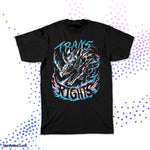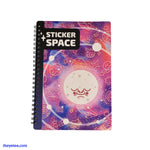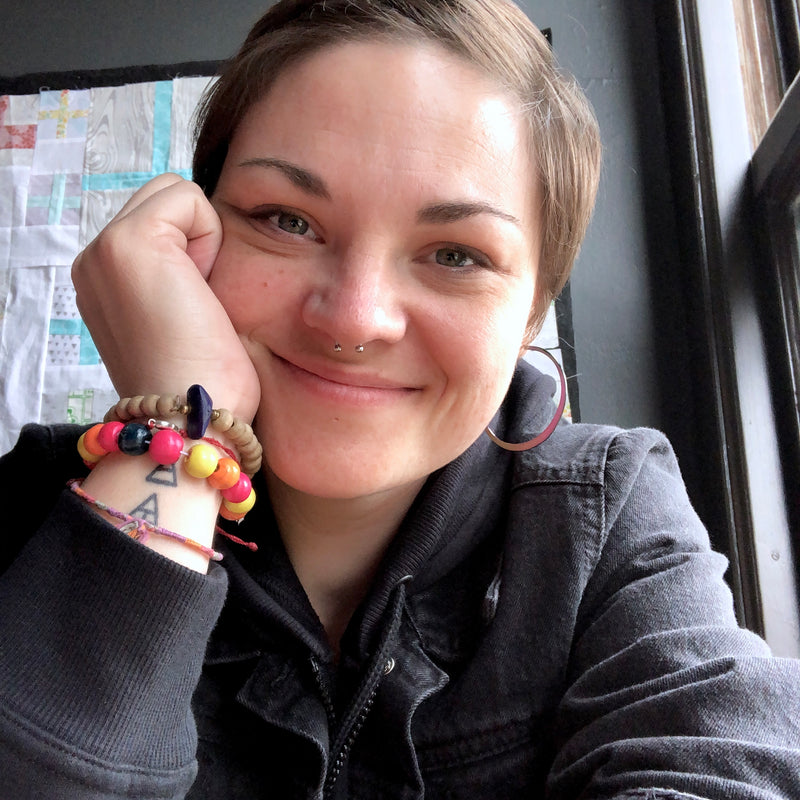An Interview With Teresa Fiehn Millies
By Jacob Chase
Teresa Fiehn Millies is an Aurora, Illinois native who creates street art from everyday objects that spread cheer, love, and positivity to anyone who manages to stumble upon it. After receiving a donation of overstock tees from us, she created something truly remarkable that we wanted to share with all of you! Titled “Reflection,” this hand-crocheted rainbow of tees is located in downtown Aurora at the corner of Stolp and Downer, and leaves this message to those who cross its path “When the rain ends, What will be?”
Over the weekend I got the chance to chat with Teresa and comb through her attic of creativity to shed some light on this mural, her motivations as an artist, and the passion she has for what she does:

Jacob Chase: How long have you been creating street art?
Teresa Fiehn Millies: I’ve been making big things for the city for about 3 years now. But I’ve been making things this way since I was about 8 years old.
JC: What does street art mean to you?
TFM: Accessibility. There is this trap of thinking that to be an artist there is only one acceptable path; to go to fine art school and show your work in a gallery. Although that is a perfectly great way to go about it. It’s far from the only way. I think street art is often Outsider Art, it’s made for the love of making, by people who often don't have formal education and it’s to be enjoyed by anyone that can see it.

Teresa's art studio
JC: Are there any influential artists, street or otherwise, that inspire you to create your own artwork?
TFM: I have never taken an art class so I know very little about traditional art or art history. I’m drawn to art that might make me a little uncomfortable, that might show me something I hadn’t considered before. Diane Arbus is a top favorite, her vibe is something that l will always be chasing... James Sowerby’s color theory illustrations from the early 1800s are my favorite paintings. I’m drawn to authenticity, bold colors, bold lines, and bold statements.
I feel inspired by the people around me. I’m surrounded by some really deeply good people. I’m inspired to make things for my mom, my aunts, and my grandmother that always had a project they were working on or anything they were fixing. My friends who stay up all night cutting out tiny pieces of paper for a collage or making prints for a convention show when they have to go into the office in the morning. I have had the privilege of living in Aurora my whole life and have been involved with the Downtown Art Scene since 2008. I've met and come to be close with so many people that don't make their career with art, but it’s something they do because they are compelled to.
I’m also inspired by my kids because they think nothing about pulling out some paper and just drawing. They don’t judge themselves or doubt their abilities. They make amazingly creative yet simple things and never minimize the work that they have done... Everyone has a unique voice. We are made to think that we aren’t important and our ideas aren’t “good”. I try really hard to get over that and find what’s behind that. Even if it’s not good, who cares. Just make the thing!

JC: What is your favorite aspect of working with physical mediums?
TFM: My favorite part is that I’m doing something that women have been doing for thousands of years. I liked that I could use my hands and figure out something that exists in space. I do “handwork”. When you hear that word you think of old ladies and a quilting bee, but there is a familiarity and warmth in that image because it is community and creation. But I want to show that this is not a bygone craft. It can be used in very modern ways to make really interesting things. I want to bring some awareness and respect to traditional handwork. It’s meditative, it often produces something useful and it promotes spatial and mathematical intelligence. I deeply enjoy how hard it is, that there are always some new techniques or stitch combinations to learn. Everything you have ever seen in crochet is made from only 5 stitches.
JC: Being a street artist, what sort of freedoms do you have in deciding where you will create each of your projects?
TFM: My first yarn bomb was on the bike rack outside All Spoked Up. I did it without permission but they loved it. Sometimes I’ve been very lucky that my work has been commissioned by the city. (Until this current one) The commissions were for the Stolp Block Party and Alley Art Fest. My limitation is that I need something to wrap my work around and tie it to. Until recently I had a studio above Vara Design. The fence is an ideal spot, that corner is the center of the world on First Fridays. I want to make more things in more places. The downside of outside art is that it is subject to the sun, wind, and rain. Fabric only lasts a couple of months. I’d like to do more installations inside just because of that. Maybe window displays. All I really want to do is add color and depth. The contrast of the green, brown, and gray city with bright yarn just feels good. I’m always open for commissions and ideas.

JC: Do you only do street art or are there other projects that you work on?
TFM: Writing is my first love. To scratch that itch I make zines. I write about esoteric, metaphysical, occult, Tarot, and whatever else I find interesting. It’s called Third Arcana and I sell them and leave them around places. My daughter made some zines too and we had a table at Chicago Zine Fest last year. I don't think anyone is JUST a writer or JUST a painter. It feels wrong to even say what KIND of artist you are? I think we are all makers. It’s about figuring out how to do the thing so it can live outside your head. I crochet, embroider, knit, sew, and quilt. Large Installations are my favorite thing to do because it’s accessible and the scale is so fun. That said I will always be the one to give a baby blanket at a baby shower. I feel like we are losing the generation that gave us our first blanket and I hate that babies aren’t getting blankets that were stitched by hand with them in mind.
JC: Is recycling an important aspect of all of your artwork?
TFM: It hasn't been but it’s something that I want to become a main aspect. I want to do more things for free with donated materials. I think everything we need already exists in someone’s closet or basement. We live in a culture where we believe that once we buy something it's ours and we will keep it even if we may never need it again. Or the other side of that coin is that we over buy and then just throw out the extra. We all have things we don't use and don't need and I wish there was a place that we could all put those things so that when someone else needs it, there it is.

JC: What kind of emotions do you try to evoke with your work, and what has been your favorite memory from that process?
TFM: I try to evoke all of them. I want people to stop walking and notice something. We are on our phones all the time and we don't live in the moment. Generally, we don't think about the impact we are making, or how our actions affect others. We just do our lives and most days are the same as the last. I like things that disrupt that. I want to learn and I want to understand people and ideas that I haven’t been exposed to. If something like a bright rainbow on a fence, or a butterfly, or an arrow makes people stop and look then that’s good. Changes the beat a bit.
JC: What does this particular mural mean to you?
TFM: The mural says “When the rain ends, What will we be?” I knew I wanted to do a rainbow but I needed words. The etymology of words is something that I’m very interested in. It's got to be exactly right. But I didn't know what I was going to do until I had the rainbow on the fence.
The rainbow is a symbol that is being seen around the world to symbolize inclusion. That everyone is in this together. So I looked up the science of how a rainbow is created. Turns out you can only see a rainbow if you are standing between the rain and the sun. The sun behind you reflects the water that is in front of you. You have to be in a reflection, a pause between the two. And that’s exactly what we are doing. We’re literally on hold right now. I think we should be reflecting on who we are and who we want to be when this is done. Not just personally, but as a community and country and world. Look at what we have come to accept as the norm. We need to decide if this is how we want to continue. When the rain ends. What will we be?

If you want to stay up to date with Teresa’s work keep an eye out on her corner fence spot in downtown Aurora for more artwork throughout the year. Also, check out her Instagram and website where she regularly updates about what she is working on and planning!
Website: https://www.queenofmarigold.com/
Instagram: https://www.instagram.com/queen.of.marigold
If you have any excess materials or items you might never use, think about donating them to a local shelter or artist... You never know what magical thing might come from such a gift!



